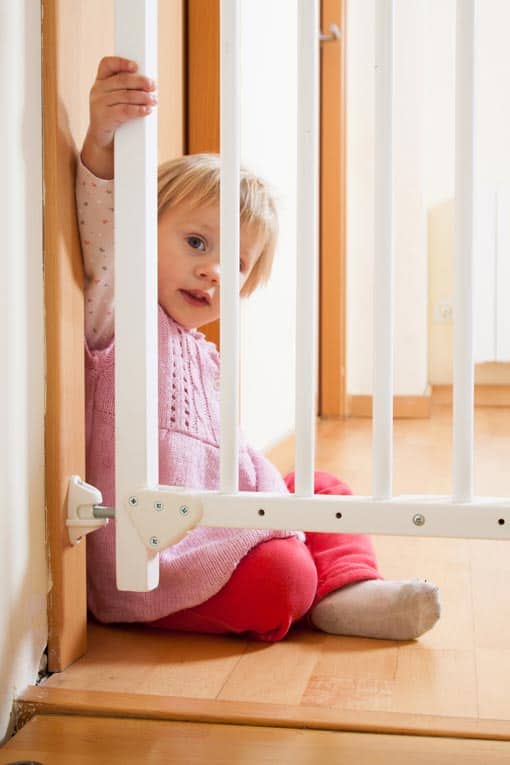 Daria Filimonova / Shutterstock.com
Daria Filimonova / Shutterstock.com A secure baby gate can prevent little ones from trying to navigate up or down a staircase.
For small kids, stairs and landings look like a lot of fun, but can be very hazardous unless you take certain childproofing precautions.
Safety gates. At both the top and bottom of open stairs, install safety gates. For more information, see Buying Child Safety Gates & Playpens.
Lighting. Be sure all foot-traffic areas are well lighted without glare or shadows. Three-way light switches (to turn lights off or on from either end of a hall or stairs) are helpful. If your house isn’t wired for these, plug a nightlight into a nearby outlet (include an outlet cover).
Sure footing. For clear, easy passage, regularly remove obstacles, eliminate throw rugs, and install non-slippery surfaces underfoot. Clean up spills immediately, and prevent a child from walking on wet floors.
Climbing skills. To a toddler, climbing stairs is an exciting accomplishment, as well as an exercise that develops coordination and muscle. Small children need to learn how to go up and down stairs properly (crawling down backwards is safest for toddlers). Accompany them while they’re learning.
Treads & risers. Make sure that stairs are in good structural condition and have slip-resistant tread surfaces. Wall-to-wall, low-pile carpeting is soft underfoot for both stairs and hallways and provides some cushioning in case of a fall.[GARD align=”right”]
Stairs with open risers are dangerous for young kids, who can crawl right through them. Be especially watchful if your home has such a staircase. Also be vigilant if you have a spiral staircase because its turns can be difficult to negotiate; metal spiral staircases can have hard, sharp edges. Block all such staircases at top and bottom with safety gates.
Keep stairs free of clutter. You’ll invite stumbling if you use them for collecting items that need to go to the upper or lower floor.
Railings. An ideal child-safe stairway would have two parallel handrails on each side: one placed at a comfortable level for adults (30 to 34 inches above the tread’s nosing) and a lower one placed where it can be easily grasped by children. You can buy railings and brackets at a building supply store. Screw the railing securely into wall studs.
Open railings of sturdy and smooth balusters can also give children a good grip as they climb stairs. These open railings on stairs, landings, and upper levels should be at least 36 inches high. If balusters are spaced wide enough that a small body could squirm between them, provide a barrier by temporarily clamping sheets of 1/16-inch clear acrylic or styrene plastic to the railing or balusters using electronic cable ties.
Featured Resource: Get a Pre-Screened Local Home Childproofing Pro
